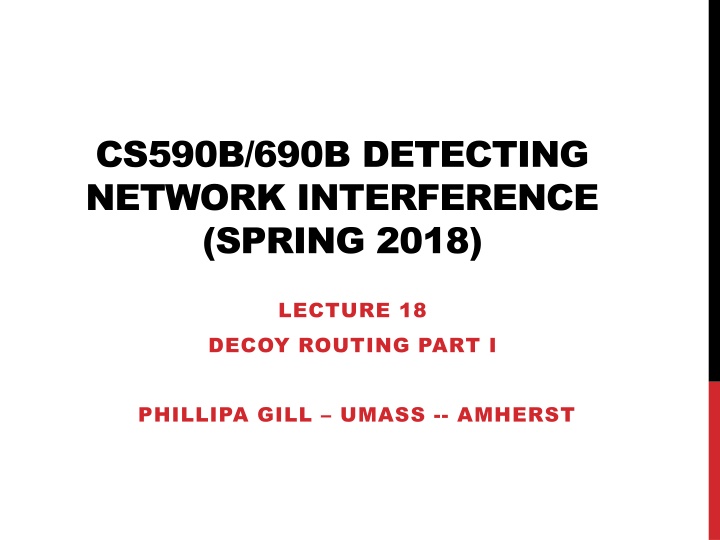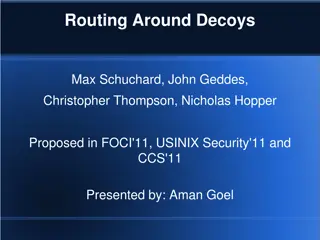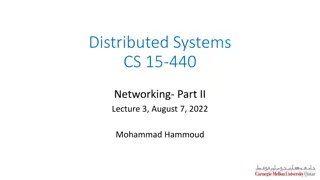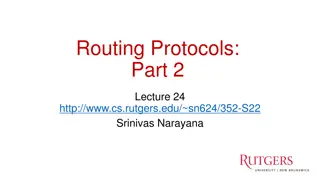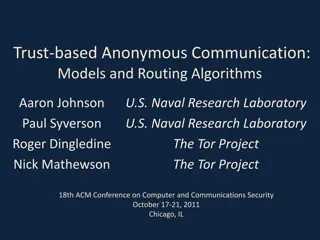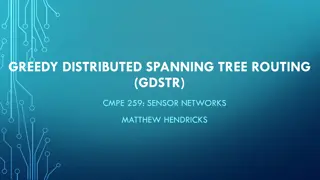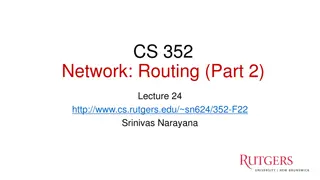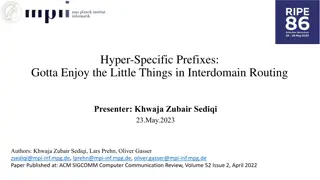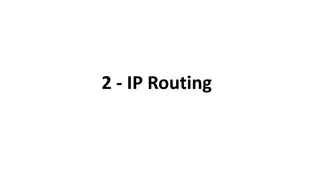Decoy Routing in Internet Circumvention Strategies
Decoy routing in network interference involves making hosts on the internet appear as proxy servers, enabling access to blacklisted sites with normal latency and throughput. The approach aims to maintain content secrecy and actual destination privacy by making traffic filtering difficult for intermediate routers. Various techniques like Telex and Tap Dance are discussed, highlighting the challenges and strategies involved in circumventing network censorship.
Download Presentation

Please find below an Image/Link to download the presentation.
The content on the website is provided AS IS for your information and personal use only. It may not be sold, licensed, or shared on other websites without obtaining consent from the author.If you encounter any issues during the download, it is possible that the publisher has removed the file from their server.
You are allowed to download the files provided on this website for personal or commercial use, subject to the condition that they are used lawfully. All files are the property of their respective owners.
The content on the website is provided AS IS for your information and personal use only. It may not be sold, licensed, or shared on other websites without obtaining consent from the author.
E N D
Presentation Transcript
CS590B/690B DETECTING NETWORK INTERFERENCE (SPRING 2018) LECTURE 18 DECOY ROUTING PART I PHILLIPA GILL UMASS -- AMHERST
WHERE WE ARE Last time: Parrot is dead + Cover Your Acks Today Decoy routing overview Telex Tap Dance (video) Recommended viewing: https://2459d6dc103cb5933875- c0245c5c937c5dedcca3f1764ecc9b2f.ssl.cf2.rackcdn.com/sec 14/wustrow.mp4
REVIEW QUESTIONS 1. Why is imitating an existing protocol challenging? 2. How are some ways that SkypeMorph fails to evade detection? 3. What about Stegotorus? 4. What is key difference between Freewave and SkypeMorph? 5. How does Freewave try to evade detection? Why does it fail? What are the three types of mismatch that can cause mimicking to fail? Give examples 6.
TODAY: DECOY ROUTING Bake circumvention into network routing. Four key papers: Decoy Routing (FOCI 2011) Cirripede (CCS 2011) Telex (Usenix Security 2011) Tap Dance (Usenix Security 2014) Follow ons: (next class) Routing Around Decoys (CCS2012) No Way Home (NDSS 2014)
CHALLENGE OF CAT AND MOUSE Circumvention schemes we ve discussed so far require end- host participation + a proxy or relay server Constant race between detecting circumvention and coming up with new ways to hide. Censor blocks proxy IP Circumvention tool tries to hide proxy IP Put proxy in a dark net (unused IP address space) Hard for censor to find, also hard for clients Circumventor hides services in more diverse/dynamic IP addresses E.g., resource constrained home users Basic idea: get circumvention on as many IPs as possible blocking all IPs is not feasible. But can they really get enough IPs to run the circumvention?...
WHAT IF HOSTS LOOK LIKE PROXIES? Idea behind decoy routing: Make any/every host on the Internet look like a latent proxy server Every destination IP acts like a proxy server Goals: access to blacklisted sites with near normal latency and throughput Preserve secrecy of contents + true destination Threat model: Assume basic IP-filtering firewall. Assume circumvention tool, methods, and algorithms are publicly known. Key idea: It is hard to filter traffic based on an intermediate router Packet contains destination IP, not intermediate hops on the path A network has little control over the upstream paths taken by their packets Filtering 1 router can have large collateral damage (if it transits traffic for a lot of prefixes)
HOW IT WORKS Decoy router can sit on any network path and act as a proxy (or forward client traffic to a decoy proxy). But how can the client connect to the proxy? Why can it not just address a packet to the proxy destination? Solution: Connect to a decoy destination Once connected covertly signal over TCP/IP flow that the decoy router should forward the packet to the proxy Proxy then intercepts the TCP connection (drop connection to decoy destination) and act as a regular proxy.
HOW IT CIRCUMVENTS Makes IP filtering ineffective because the destination IP is meaningless IP on the path is tunneling traffic elsewhere. Nearly any IP address (depending on decoy router location) can be a decoy destination Components of decoy routing: Client software, decoy router, decoy proxy + covert signalling mechanism Decoy router must be able to maintain line rate communication while looking for covert signaling Decoy proxy needs to be able to hijack TCP session to communicate with the client
STEP 1: CONNECT TO DECOY DESTINATION Client needs to find a path with a decoy router Create TCP/IP connections to different destinations Try inserting sentinels (covert requests) into the connection E.g., put a special string in an HTTP cookie header If a decoy proxy replies with a hello message the client knows there is a proxy on the path.
STEP 2: COVERTLY REQUESTING DECOY ROUTING Example sentinels: String generated by symmetric key (exchanged out of band) Client tries a sequence of ports to signal the decoy routing Series of payload lengths anything easily detectable by an IDS Decoy routing paper: Uses sentinel generated based on time and a secret key shared between the client and the proxy Client includes this in the random number field in the Client TLS Hello message Router forwards messages with sentinel to the proxy Proxy allows client to finish TLS exchange with the decoy destination (so all clear text communication looks normal) Proxy then sends hello in the TLS connection TLS traffic should be shaped to match underlying destination
STEP 3: HIJACKING A TCP FLOW Proxy sends a RST to the destination with the sequence number on the packet that the client uses to signal the proxying It can match the header values So the destination won t try to send any RSTS or consider it out of order Challenge: No assumption that path is symmetric Proxy/decoy router can see traffic from client, but not necessarily from the server Needs to glean server TCP options from the headers Client can convey these values to the proxy via the covert channel (since the client does have communication with the server)
STEP 4: PROVIDE PROXY SERVICES Many standard proxy protocols E.g., SOCKS proxy forwarded to a standard SOCKS server by the decoy proxy.
VULNERABILITIES Detection: censor can cut off Internet access to clients caught using decoy routing Detection channels: MTU, IP TTL value, RTT Decoy proxy can adjust these values to match and reduce risk Censor can replay the TLS hello message and look for a response that looks like it is from a decoy proxy Make sentinels such that they cannot be reused Record a response from the decoy destination and forward that along to any repeated sentinels Censor could hold TLS hellos and forward them to the correct destination and only forward that reply back to the client Adversary could ID clients using the system Clients can access decoy destinations but not the proxy service Also DoS if the censor gets access to the user software and opens many connections
